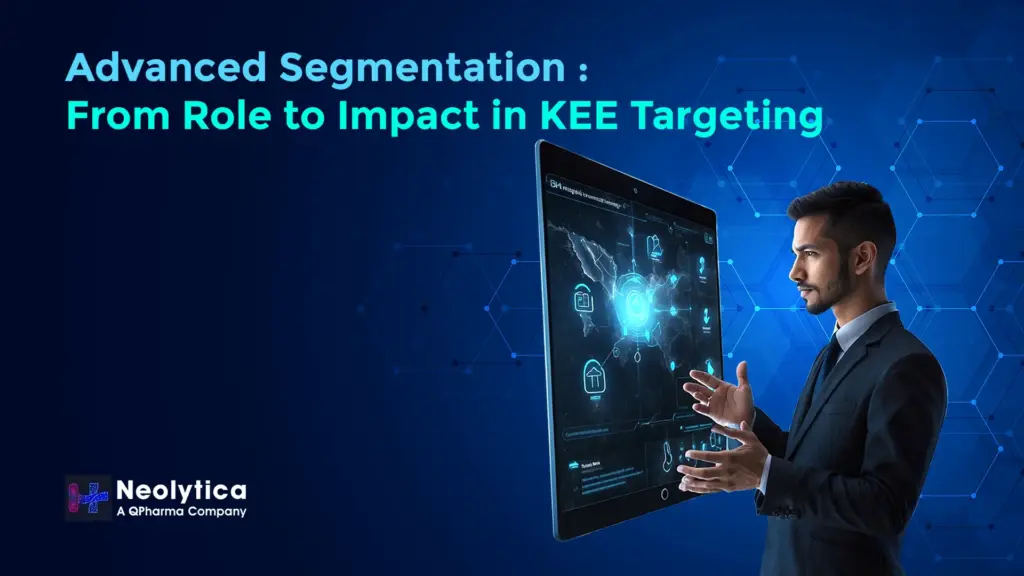Not all influence looks the same. Some experts write guidelines, others steer trial sites, and a growing cohort shapes thinking online. Effective KEE targeting starts with segmentation that goes beyond “who is famous” to “who moves decisions and how.” Here’s a practical framework to build advanced segments from role (what the expert does), to behavior (how and where they engage), to resonance (the real-world impact of their voice).
Why “advanced” segmentation?
Teams that rely only on lists or follower counts miss critical nuances like care setting, collaboration patterns, and the quality of peer engagement. Data-driven segmentation improves precision, prioritization, and campaign effectiveness across medical and commercial use cases.
The segmentation layers that matter
1) Role: what the expert does in the ecosystem
Classify experts by practical roles that influence adoption:
- Evidence stewards: guideline authors, principal investigators, DSMB members
- Care path leaders: heads of service lines, formulary committee participants
- Educators & conveners: congress session leads, CME faculty, workshop hosts
- Digital voices: DOLs who catalyze discussion among HCPs
Role clarity helps align engagement (e.g., evidence reviews vs. payer conversations) to each expert’s day-to-day influence.
2) Topic fit: anchor to your medical priorities
Build a curated, searchable database tagged to therapy area, subtopic, method focus (e.g., real-world evidence, imaging), and geography. Topic-level tagging ensures outreach matches the exact clinical questions your field and medical teams are tackling now.
3) Setting & access
Differentiate academic centers, community hospitals, IDNs, private groups, and telehealth footprints. Access dynamics (IRB experience, trial capacity, payer mix) strongly affect who can activate change locally.
4) Behavior: where and how they engage
Capture cadence and channel preferences: congress sessions, specialist forums, webinars, peer-review, and select social platforms. Behavior profiles guide format and timing; roundtables for methodical reviewers, rapid Q&A for fast-cycling digital contributors.
5) Network context
Look for repeated co-work (co-authored papers, multi-center trials, shared panels) and for people invited across institutions or adjacent specialties. These “connectors” help ideas travel, even if they post infrequently.
6) Impact: from mentions to meaningful actions
Prioritize experts whose contributions trigger peer debate, article downloads, MSL inquiries, or requests for data/demos. This kind of engagement quality predicts behavior change better than raw impressions.
7) Sentiment & trajectory over time
Track tone by topic (supportive, neutral, skeptical) and note inflection points around congress abstracts, safety updates, or guideline revisions. Pair sentiment shifts with downstream actions (e.g., evidence requests, advisory interest) to spot early market turns.
8) Enablement readiness
Some experts influence because they’re well supported. Score gaps and provide what they need, such as method summaries, de-identified RWE, and patient materials, so influence becomes measurable action.
Building the data foundation
- Multisource aggregation: Publications, congress roles, advisory rosters, specialist forums, and curated digital activity, kept current and compliant.
- Quality controls: Standardize names/affiliations, deduplicate profiles, and log conflicts/COIs up front.
- Outcome mapping: Link segments to business goals, trial site activation, HCP education, payer evidence needs, and track movement against those objectives.
From segmentation to action
- Match role to tactic
- Evidence stewards → pre-publication briefings, methods reviews
- Care path leaders → pathway/prior-auth conversations
- Educators → CME content, case-based workshops
- Digital voices → concise visuals, FAQ threads, and timely clarifications
- Sequence by moments that matter
Align outreach to data drops, registry updates, or guideline cycles; quieter experts often choose these windows to weigh in, when their voice carries the most weight. - Measure what changes
Replace vanity metrics with behavioral endpoints: protocol tweaks, trial referrals, formulary discussions initiated, MSL follow-ups, and qualified HCP leads from medical content.
Compliance, credibility, and trust
A strong KEE program respects boundaries: transparent disclosures, content routed through medical-legal-regulatory (MLR), patient privacy safeguards, and bias checks in data pipelines. These foundations protect programs and enhance expert trust.
How Neolytica supports “role-to-impact” targeting
Neolytica’s Ti-Expert brings these pieces together:
- Unified expert profiles spanning publications, congress activity, advisory work, clinical trials, and controlled digital media. (100,000+ sources)
- Topic-level tagging so teams can filter by sub-specialty, method focus, and geography, instantly aligning outreach to medical priorities.
- Resonance and sentiment tracks that connect expert tone to real requests and HCP actions.
- Enablement workflows to package the right evidence at the right time, turning influence into measurable outcomes.
In conclusion, advanced segmentation isn’t about louder lists; it’s about precision. When you connect role, behavior, and resonance, your teams find the experts who actually change practice, engage them in the right moments, and measure what matters. If you’re ready to operationalize this approach, Neolytica can help you build an Expert Universe that’s current, compliant, and action-ready.

